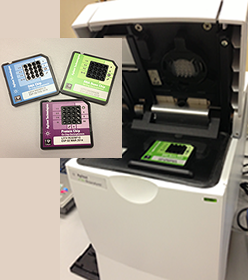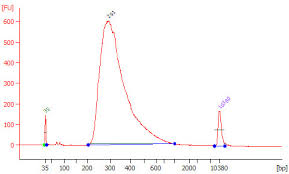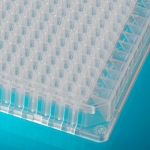|
| |
| Genomic Services |
|
| Protein Services |
|
| |
| |
Located in rooms
B065 and B017
|
|
** QC for RNA/DNA samples can be done on the Agilent 2100 Bioanalyzer, (Capillary Electrophoresis) Fragment Analyzer and Femto Pulse system. These platforms provide comparable results.
**Please review the details below to determine which machine is best suited for your needs.
**You should also check the submission requirements for each machine before placing your orders.
|
Agilent Bioanalyzer |
Fragment Analyzer |
| microfluidics-based with the lab-on-chip technology |
96 capilllary eletrophoresis |
min/max samples per order |
no limit per order |
No limit. Maximum 95 samples per plate (last well is reserved for ladder) |
Sample submission |
Individual tubes or plate |
Plate format only |
Pricing |
$ per sample |
$ per plate |
DNA |
up to 10 Kb
|
up to 48 Kb
|
RNA |
Data output includes: total RNA concentration and RNA integrity number (RIN). |
Data output includes: total RNA concentration and RNA quality number (RQN). |
Small RNA |
Sample: Resolution of single stranded RNA fragments up to 150nt. |
Sample: Distinguishes between the microRNA region (10-40nt) and small RNA region (10-200nt). |
Quality |
The RNA Integrity Number (RIN) is a score on a scale of 1-10 used to approximate the integrity of total RNA. This score accounts for presense or absence of degraded products and is often used as a quality metric to determine the viability of total RNA for an experiment. |
The RNA Quality Number (RQN) is an assesment of the quality of total RNA using a 1-10 scale and can be compared to the BioAnalyzer RIN score. |
Agilent Bioanalyzer QC : (back to top)
• General Info. --
The Agilent 2100 Bioanalyzer is a microfluidics-based 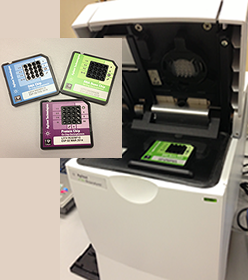 platform, and with the lab-on-a-chip technology, it can provide sizing, quantification and quality control of DNA, RNA, proteins and cells in a short period of time. Each Agilent chip contains an interconnected set of microchannels that is used for separation of nucleic acid fragments or proteins based on their size as they are driven through it electronically. platform, and with the lab-on-a-chip technology, it can provide sizing, quantification and quality control of DNA, RNA, proteins and cells in a short period of time. Each Agilent chip contains an interconnected set of microchannels that is used for separation of nucleic acid fragments or proteins based on their size as they are driven through it electronically.
§ Assays and their applications --
PAN Facility currently offers different assays for a wide range of applications:
- DNA Assays (DNA 1000 and High Sensitivity DNA): provide sizing and quantification of DNA fragments and DNA smears down to pg/ul sensitivity.
- RNA Assays:
Total RNA Assay
(Eukaryote, Plant, Prokaryote) |
provides RNA quality check with RIN (RNA Integrity Number), a quantification estimate and ribosomal ratios for total RNA and mRNA samples. |
mRNA Assay |
provides a quantitation estimate and percentage of rRNA contamination. No RIN provided. |
- Small RNA Assay: provides verification and optimization of miRNA after extraction procedures; analyzes miRNA directly in total RNA or in enriched samples; compares small RNA regions in extracts and tissues; separate miRNA from other small RNAs.
|
Please use the following table as a guide to choose the right assay for your samples. Before submitting your samples, you must also check out the concentration requirements for the assay chosen since each assay has different sensitivity level.
| Starting Material |
Sample Type |
Assay Type |
Size Analysis Range |
* Sample Concentration
-
Detection Range |
DNA |
dsDNA, cDNA, genomic DNA, NGS DNA |
| • DNA 1000 |
| • High-Sensitivity DNA |
|
| 25 - 1000 bp |
| 50 - 7000 bp |
|
| 1ng/ul-50ng/ul |
| 5pg/ul-5ng/ul |
|
RNA |
Total RNA, mRNA, cRNA, fragmented RNA, microRNA |
| • Nano RNA (Eukaryote, Plant, Prokaryote) |
| • Pico RNA (Eukaryote, Plant, Prokaryote) |
| • Small RNA (6-150 nt) |
|
| 25 - 4000 nt |
| 25 - 4000 nt |
| 6 - 150 nt |
|
| 5ng/ul-500ng/ul |
| 50pg/ul-10ng/ul |
| 50pg/ul-2ng/ul |
|
| * Although the Bioanalyzer is capable of detecting the lowest concentration amounts shown, we would recommend to have your sample(s) in the higher detection range for better results. |
|
• Data Release --
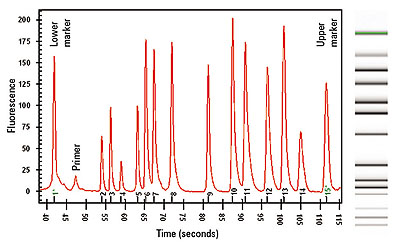 The data generated from the Agilent 2100 Bioanalyzer will be emailed to you in .pdf format and/or .xad format. The data generated from the Agilent 2100 Bioanalyzer will be emailed to you in .pdf format and/or .xad format.
- PDF file - contains run summary, assay details, electropherogram, gel image, result tables and the ladder info. The sample will be named as such, 'your initials'_'sample name'.
- XAD file - is raw data file, which can be viewed using the free, downloadable Agilent 2100 Expert Software. This software allows you to manipulate the data at the regions of interest (specifically useful for DNA assays). For details about the sofware and what you can use it for, click here.
|
• Data Analysis --
• Turn-around Time --
Samples are usually processed within 24 hours and they will be disposed of after all successful runs. If sample return is requested, samples will be left for pick up in the back of the freezer and saved for one week. After one week, the samples will be disposed. |
|
|
Fragment Analyzer QC: (back to top)
• General Info. --
The Advanced Analytical Fragment Analyzer is a capillary electrophoresis based platform that provides sizing and quality control of DNA and RNA in a plate format.
* Fragment resolution from 10bp to 50,000bp
* Resolution down to 3bp
* Detection from 5 pg/ul
§ Assays and their Applications --
PAN Facility currently offers different assays for a wide range of applications:
- DNA Assays
* NGS Library QC
|
| * Large Fragment QC |
| * Genomic DNA QC |
- RNA Assays:
* Small RNA QC (5nt-200nt)
|
| * Standard Sensitivity RNA QC (15nt-6,000nt) |
| * High Sensitivity RNA QC (15nt-6,000nt) |
|
Please use the following table as a guide to choose the right assay for your samples. Before submitting your samples, you should check the concentration requirements of each assay. Please use the following table as a guide to choose the right assay for your samples.
| Starting Material |
Kit Type |
Assay Type |
Size Analysis Range |
* Sample Concentration
-
Detection Range |
DNA |
NGS DNA |
| • NGS Library QC (Standard Sensitivity) |
| • NGS Library QC (High Sensitivity) |
| • NGS Library QC (High Sensitivity Small Fragment) |
|
| 25bp - 5,000bp |
| 25bp - 5,000bp |
| 50bp - 1,500bp |
|
| 0.1ng/ul - 10ng/ul |
| 5pg/u l- 500pg/ul |
| 5pg/ul - 500pg/ul |
|
| Large Fragment |
| • Large Fragment QC (Standard Sensitivity) |
| • Large Fragment QC (High Sensitivity) |
| • Large Fragment 50kb QC (High Sensitivity) |
|
| 50bp - 20,000bp |
| 50bp - 20,000bp |
| 75bp - 48,500bp |
|
| 0.1ng/ul - 10ng/ul |
| 5pg/ul - 500pg/ul |
| 5pg/ul - 600pg/ul |
|
| gDNA |
| • gDNA QC (Standard Sensitivity) |
| • gDNA QC (High Sensitivity) |
| • gDNA 50kb QC |
|
| 50bp - 20,000bp |
| 50bp - 20,000bp |
| 75bp - 48,500bp |
|
| 5ng/ul - 200ng/ul |
| 50pg/ul - 5ng/ul |
| 25ng/ul - 250ng/ul |
|
RNA |
|
| • Small RNA |
| • RNA (Standard Sensitivity) |
| • RNA (High Sensitivity) |
|
| 5nt - 200nt |
| 15nt - 6000nt |
| 15nt - 6000nt |
|
| 50pg/ul - 2ng/ul |
| 25ng/ul - 500ng/ul |
| 500pg/ul - 5ng/ul |
|
|
• Data Release --
The data generated from the Advanced Analytical Fragment Analyzer instrument will be emailed to you in .pdf and .xls format.
- PDF file - contains run summary, method information, gel image, and trace for each sample.
- Excel file - contains concentration, molarity, and size information.
|
• Data Analysis --
• Turn-around Time --
Orders will be processed within 2 days of submission. |
|
|
Femto Pulse QC : (back to top)
• General Info. --
The Femto Pulse system provides researchers with a powerful and automated pulsed-field capillary electrophoresis system. Easily achieve 10 times higher sensitivity for smears and up to 100 times for fragments.
|
• Data Release --
• Data Analysis --
• Turn-around Time --
|
|
.
|
